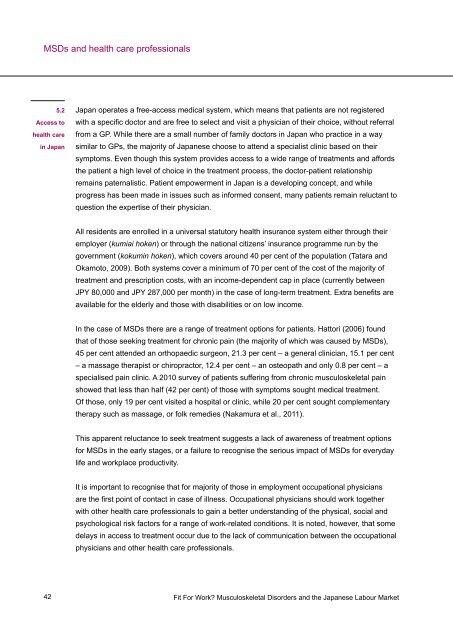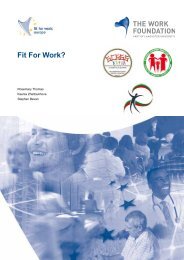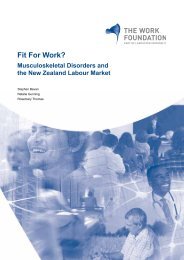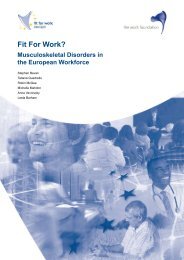English version - Fit for Work Europe
English version - Fit for Work Europe
English version - Fit for Work Europe
You also want an ePaper? Increase the reach of your titles
YUMPU automatically turns print PDFs into web optimized ePapers that Google loves.
MSDs and health care professionals<br />
42<br />
5.2<br />
Access to<br />
health care<br />
in Japan<br />
Japan operates a free-access medical system, which means that patients are not registered<br />
with a specific doctor and are free to select and visit a physician of their choice, without referral<br />
from a GP. While there are a small number of family doctors in Japan who practice in a way<br />
similar to GPs, the majority of Japanese choose to attend a specialist clinic based on their<br />
symptoms. Even though this system provides access to a wide range of treatments and af<strong>for</strong>ds<br />
the patient a high level of choice in the treatment process, the doctor-patient relationship<br />
remains paternalistic. Patient empowerment in Japan is a developing concept, and while<br />
progress has been made in issues such as in<strong>for</strong>med consent, many patients remain reluctant to<br />
question the expertise of their physician.<br />
All residents are enrolled in a universal statutory health insurance system either through their<br />
employer (kumiai hoken) or through the national citizens’ insurance programme run by the<br />
government (kokumin hoken), which covers around 40 per cent of the population (Tatara and<br />
Okamoto, 2009). Both systems cover a minimum of 70 per cent of the cost of the majority of<br />
treatment and prescription costs, with an income-dependent cap in place (currently between<br />
JPY 80,000 and JPY 287,000 per month) in the case of long-term treatment. Extra benefits are<br />
available <strong>for</strong> the elderly and those with disabilities or on low income.<br />
In the case of MSDs there are a range of treatment options <strong>for</strong> patients. Hattori (2006) found<br />
that of those seeking treatment <strong>for</strong> chronic pain (the majority of which was caused by MSDs),<br />
45 per cent attended an orthopaedic surgeon, 21.3 per cent – a general clinician, 15.1 per cent<br />
– a massage therapist or chiropractor, 12.4 per cent – an osteopath and only 0.8 per cent – a<br />
specialised pain clinic. A 2010 survey of patients suffering from chronic musculoskeletal pain<br />
showed that less than half (42 per cent) of those with symptoms sought medical treatment.<br />
Of those, only 19 per cent visited a hospital or clinic, while 20 per cent sought complementary<br />
therapy such as massage, or folk remedies (Nakamura et al., 2011).<br />
This apparent reluctance to seek treatment suggests a lack of awareness of treatment options<br />
<strong>for</strong> MSDs in the early stages, or a failure to recognise the serious impact of MSDs <strong>for</strong> everyday<br />
life and workplace productivity.<br />
It is important to recognise that <strong>for</strong> majority of those in employment occupational physicians<br />
are the first point of contact in case of illness. Occupational physicians should work together<br />
with other health care professionals to gain a better understanding of the physical, social and<br />
psychological risk factors <strong>for</strong> a range of work-related conditions. It is noted, however, that some<br />
delays in access to treatment occur due to the lack of communication between the occupational<br />
physicians and other health care professionals.<br />
<strong>Fit</strong> For <strong>Work</strong>? Musculoskeletal Disorders and the Japanese Labour Market







